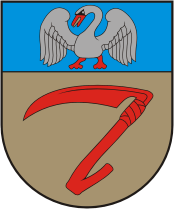
Siaulenai, Lithuania
(Other Names: Shavlan, Shavlyan, Shavlyany, Siauleny, Shyaulenay, Savlan, Shavlian, Sialenai or Szawlany)

The Grazutis Family
“Es vet bald kumen an andere milkhome”
To view the text corresponding to a footnote click the footnote number and then click the link at that location
My grandparents Yechezkel and Sarah Toba Grazutis lived in Siaulenai, Lithuania from the 1890’s through September of 1923. In my research, I could not find any official records of them living there. However, based on what my mother told me, and according to the Ellis Island records and the Ship Manifest, they originated from Siaulenai, Lithuania.
My grandparents had eleven children. Seven children died either in infancy or from various diseases.
When the visiting photographer came to the Shtetl, Shavlan (Siaulenai) in 1907, a group picture was taken of the Grazutis family.1
My grandmother was a baker and sold pastries and breads in the local market while my grandfather worked as a tailor, making clothes for the inhabitants of the town.
My grandfather was not very happy living in Siaulenai. He traveled quite a lot to various countries. He traveled to England to visit his sister and America twice to visit another sister. He was looking for a place to resettle his family. He did not like the United States because he thought the Jews living there were not religious enough for him. He went to South Africa in 1913, before the First World War, hoping to establish a business there and bring his family there to live.
One of my grandmother’s daughters, Rochel Leah, was growing up and becoming quite a beautiful young woman. My grandmother decided to sent her to America to live in Pittsburgh, Pennsylvania with an Aunt because she feared that the local gentile men in the town were looking at her and she was beginning to worry. She sent Rochel Leah to America late in 1913 before the War broke out.
When the First World War started in 1914, the Czar thought that the Jews could be a possible ally of Germany and deported them from the Kovna district to the Russian interior. My grandmother and her three children, along with the entire Jewish community of Siaulenai, were deported to Ekatrinislav in the Ukraine.
The people of Siaulenai (Shavlan) were allowed to take a few items with them to Ekatrinislav. My grandmother chose to take her grandmother’s brass candlesticks2 and the copper pot that her great-grandmother made gefilte fish in for Passover.3 The Jews remained in Ekatrinislav until the end of the First World War.
When my grandmother tried to return to Lithuania after the war, she had trouble getting back into the country because she did not have the proper papers. She talked her way passed the guards at the border-crossing station, quickly pushing her children under the gate. Luckily, the guards, after giving her a hard time, allowed her and her children to enter Lithuania.
Because of the war, my grandfather could not return from South Africa to Lithuania and was very worried about his family. When the war ended, he returned to Siaulenai and reunited with his family.
Afterwards, the Grazutis family resettled in the town. My grandfather decided to stay in Siaulenai as my grandmother did not want to live in South Africa with the children. Instead, they had a beautiful house built and opened a bakery shop in the front of the house. They had a cow, and beautiful lilac bushes in front and back of the house. My grandmother ran the store, baked her pastries, breads, and delicious taglach and had a steady stream of customers.
In the early 1920’s, my grandmother saw that conditions were changing in Lithuania and said to her family “Es vet bald kumen an andere milkhome” (Translation: “Another war will come soon”), and so grandmother Sarah Toba decided to leave Lithuania with her husband and children and immigrate to the United States. My grandfather, at first, did not want to come but my grandmother gave him an ultimatum, stating that she would leave with or without him. With that statement, she convinced him to come.
Before the Grazutis family left for America, my mother, Chaika Grazutis took one final photograph in Siauliai, circa 1922.4 My grandmother Sarah Toba packed her suitcase and, of course, wrapped the copper pot and brass candlesticks up in a towel and placed them inside. This was the only memory she wanted to have of Shavlan.
Thank goodness that she had the foresight to leave Lithuania when she did. By leaving Siaulenai in 1923, she saved the lives of her entire family. Her premonition came true in 1939 when the Second World War began.
Footnotes and Descriptions
1See File No. 11 – Grazutis Family in Lithuania, circa 1907
2See File No. 53 – Brass Candlesticks, circa 19th Century
3See File No. 52 – Copper Pot, circa 19th Century
4See File No. 51 – Chaika Grazutis, circa 1922
Written by Eunice E. Blecker
Granddaughter of Yechezkel and Sarah Toba Grazutis
July 2008
Note for Mac users: Some of the pictures pointed at by these links do not display with the Safari browser. They seem to work fine with the Firefox browser from Mozilla.This page is hosted at no cost to the public by JewishGen, Inc., a non-profit corporation. If you feel there is a benefit to you in accessing this site, your JewishGen-erosity is appreciated.
Copyright © 2008 Eunice Blecker